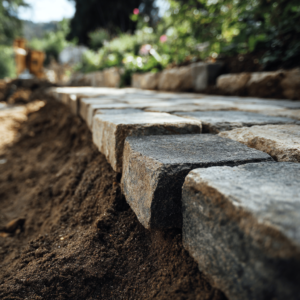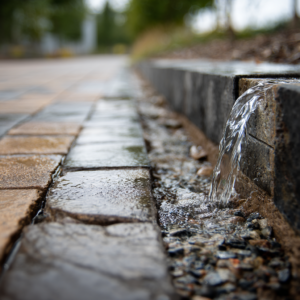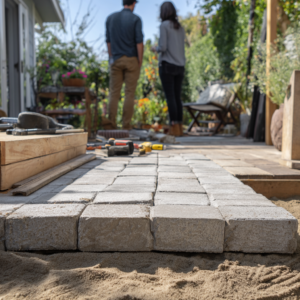For over twenty years in the hardscape industry, I’ve witnessed homeowners evolve from seeking basic functionality to demanding driveways that blend resilience with artistry. The concrete driveway with paver edging represents this shift perfectly; it’s where engineered strength meets timeless design.
This combination isn’t just about aesthetics, you see – it’s a technical solution that addresses concrete’s fundamental weakness: vulnerable edges. In this article, we will do a deep dive into why this pairing outperforms traditional approaches, how concrete pavers elevate both form and function, and what makes it a legacy investment for your home.
Read also: How to lay paver edgers – a simple 6-step guide
Jump to:
The role of paver edging in concrete driveway longevity
Every driveway’s Achilles’ heel lies at its perimeter. Unprotected concrete edges face relentless assault from tire friction, freeze-thaw cycles, and soil erosion. Traditional solutions like poured concrete curbs are even worse: they often crack under stress, while plastic edging buckles under vehicle weight.

The result is inevitably jagged, unsafe edges, requiring costly repairs within years. Paver edging transforms this vulnerability into a structural advantage; when properly installed, concrete pavers interlock to redistribute lateral pressure away from the central slab.
They create a flexible barrier against soil erosion and weed roots, while accommodating ground movement that would crack rigid materials. This dynamic protection system is why I consider paver edging not an accessory, but essential infrastructure.
Concrete pavers: the powerhouse of modern hardscape
While natural stone and clay pavers have their place, concrete pavers deliver unmatched performance for driveway applications.
Manufactured under hydraulic pressures exceeding 2,250 PSI, high-quality concrete pavers achieve compressive strengths up to 8,000 PSI, quadruple that of standard poured concrete. This isn’t superficial durability; it’s engineered resilience that withstands environmental extremes.
Unlike asphalt that softens in heat or poured concrete prone to cold-weather cracking, concrete pavers move micro-millimeters with ground shifts without surface damage. Their resistance to de-icing salts and UV radiation ensures decades of consistent performance.
When selecting units, prioritize those with a minimum 7,000 PSI rating and textured, non-slip surfaces. In snowy regions, darker hues naturally accelerate ice melt, while chamfered edges prevent snowplow damage.
See the engineering behind a bulletproof installation

The magic of a lasting concrete driveway with paver edging happens beneath the surface. Through extensive soil analysis and field testing, I’ve refined a five-layer system that defies seasonal challenges.
It begins with excavating 14–18 inches deep and lining the subgrade with geotextile fabric to prevent soil migration. Next comes a meticulously compacted base of 6–8 inches of angular, machine-crushed stone, this isn’t generic gravel but engineered aggregate that interlocks like three-dimensional puzzle pieces.
A precisely leveled inch-thick layer of coarse concrete sand follows, with deviations kept under 1/8 inch to prevent settling. The critical edge restraint phase involves installing aluminum or polymer-tracked systems in compacted trenches, spiked at strategic 60-degree angles to resist uplift forces.
Only then do we place pavers tight against the restraint with consistent 2-3 mm joints, later filled with polymeric sand that bonds into a flexible, weed-resistant matrix when activated by water.
How to transform functionality into an artistic statement
Concrete pavers shatter the myth that durability requires aesthetic compromise, but that’s simply not true. Their power lies in how they elevate a concrete driveway with paver edging from utilitarian surface to design statement.
Color psychology plays a key role here: charcoal borders framing light-gray concrete create visual lane guides that reduce accidental curb jumps, while terra-cotta tones introduce warmth against modern architecture.
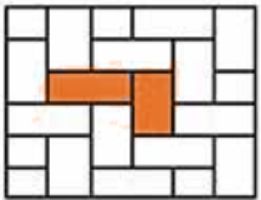
Pattern selection plays a key role here, too, merging beauty with physics; herringbone layouts at driveway entries, for example, aren’t just visually striking but provide superior load distribution where tires pivot sharply. For nighttime safety and ambiance, low-voltage LED strips can be discreetly embedded within aluminum edging.
One increasingly popular design I execute is the “floating” concrete slab bordered by permeable pavers, allowing stormwater to recharge aquifers while meeting municipal runoff regulations.
Debunking the maintenance myth
A common misconception suggests that combining materials increases upkeep. In reality, a properly engineered concrete driveway with paver edging creates a synergistic relationship where each element protects the other.
The central concrete slab typically requires resealing every 2–3 years against oil stains, while paver edges need only annual sweeping and occasional polymeric sand replenishment. Crucially, the pavers shield concrete’s vulnerable edges from direct impact, while the monolithic slab prevents border shifting.
Should damage occur, the system offers economical repairs: individual pavers can be lifted and replaced in hours without the ugly patching or full-section replacement demanded by poured concrete. This maintainability extends the driveway’s lifespan significantly, making it a fiscally smart choice long-term.

The hidden costs of DIY installation
While DIY projects can be tempting, driveway edging demands precision that online tutorials often overlook.
Proper compaction provides a prime example; bases require plate compactors delivering at least 5,000 PSI force, while most rental units max out at 3,000 PSI.
Drainage calculus presents another pitfall; achieving the essential 2% slope away from foundations becomes complex when tree roots or clay soil interfere, and mis-sloped driveways can dangerously funnel water into garages.
Even cutting precision matters immensely, as concrete pavers demand diamond blades and steady hands. A single misaligned cut can waste premium materials and compromise structural integrity.
I’ve repaired DIY installations where omitted geotextile fabric allowed soil infiltration that created hazardous sinkholes beneath vehicle tires. These corrections frequently cost multiples of a professional installation.
Build a legacy that welcomes you home with JS Brick!
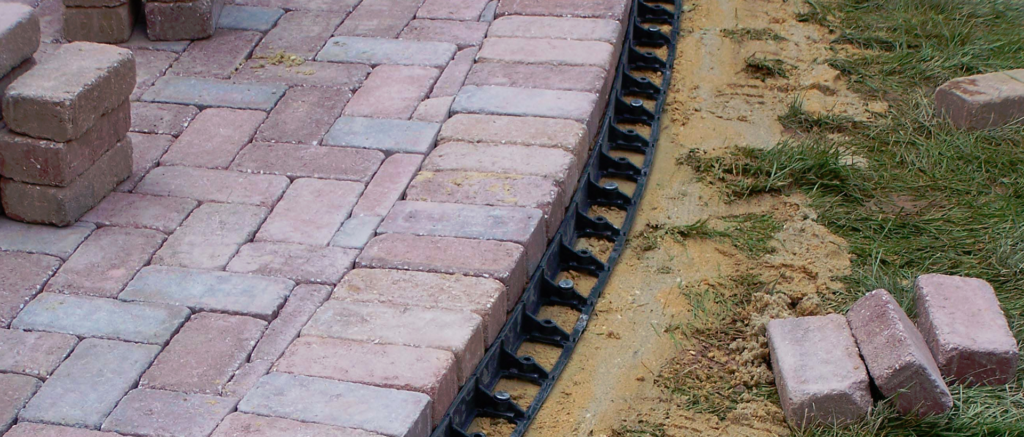
A concrete driveway with paver edging represents more than pavement – it’s the handshake between your home and the world, blending unyielding resilience with thoughtful design.
Concrete pavers ensure this durability doesn’t sacrifice elegance, creating an entrance that withstands decades of winters, celebrations, and everyday comings and goings.
Here at JS Brick, we approach each installation as permanent infrastructure, selecting erosion-resistant aggregates and hand-finishing every joint to create driveways that outlast mortgages.
Driveways shouldn’t be replaced; they should evolve with your life. So wait no more: if you’re ready to explore how concrete pavers can transform your entrance, get in contact today for a free consultation. Let’s craft an enduring first impression together!

